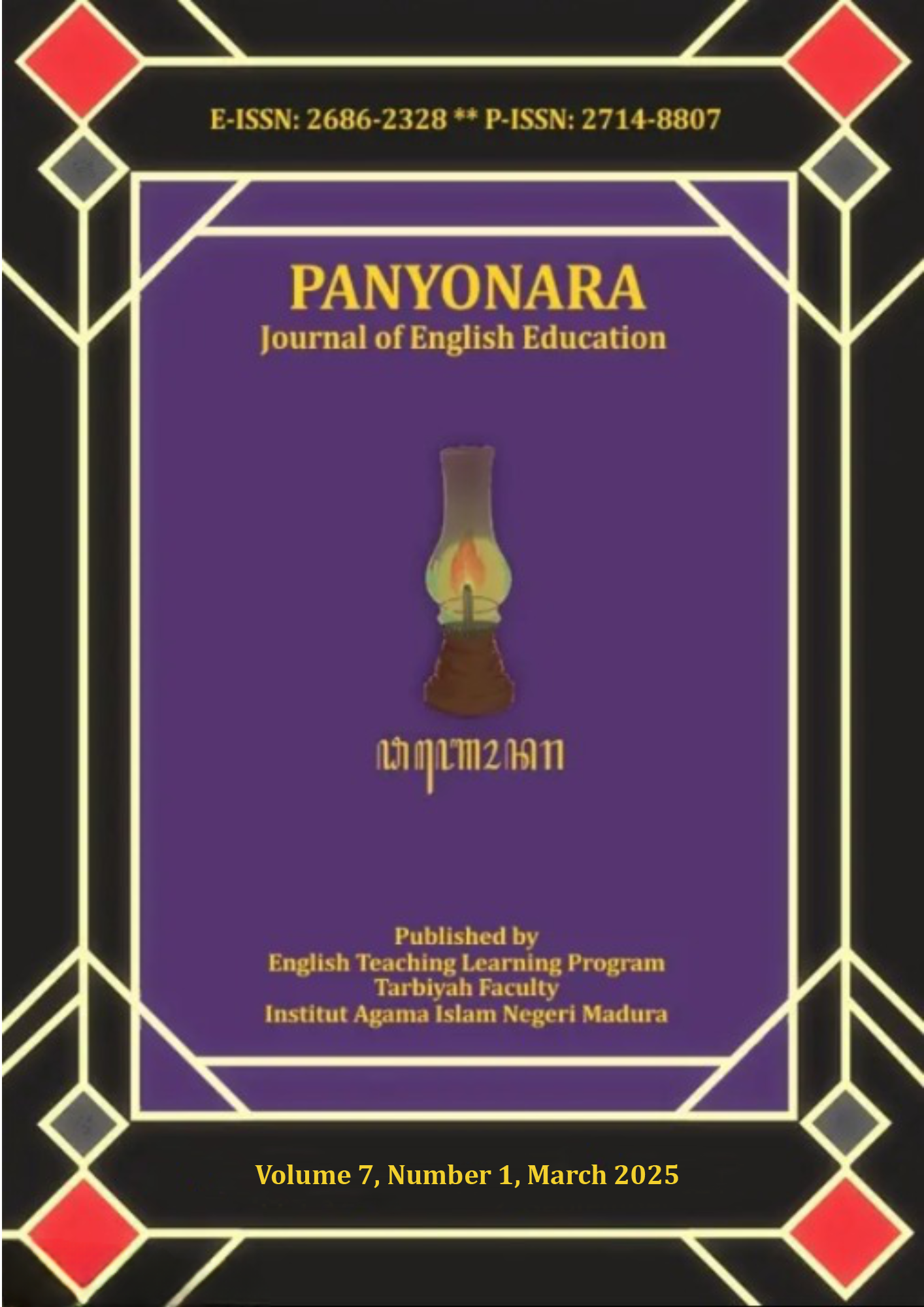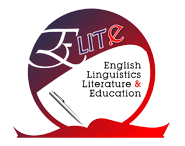Enhancing Communication Skills through Translanguaging in Pesantren-Based English Club
 Abstract views: 32
,
Abstract views: 32
,
 pdf downloads: 44
pdf downloads: 44
Abstract
Translanguaging has become a significant concept in multilingual education, particularly in pesantren-based schools where students frequently use multiple languages, including Indonesian, English, Arabic and local languages. This study aims to explore how translanguaging is practiced by students in English Club activities and its effectiveness as a tool for enhancing communication. Using a qualitative approach, data were collected through observations, interviews, and audio recordings of students engaged in English Club activities at pesantren-based school. The findings reveal that translanguaging is a flexible and dynamic practice, enabling students to naturally mix languages to comprehend complex ideas, express emotions and build confidence. It also fosters active participation, creativity, and collaboration, helping students effectively navigate academic and personal discussions. This study draws on Vogel and Garcia’s (2017) theory, which emphasizes the use of students’ full linguistic repertoire, and Cenoz and Gorter’s (2017) distinctions between planned and spontaneous translanguaging. The results confirm these theories and extend their application to the pesantren context, illustrating how translanguaging enhances communication, supports collaborative learning, and promotes cultural understanding. Practical recommendations are provided for educators to integrate translanguaging into teaching strategies, creating an effective learning environment for multilingual students.
Downloads
References
Azami, M. I. (2021). A Contradiction of the Existence of English in Rural and Urban Pesantren in Indonesia. IJET (Indonesian Journal of English Teaching), 10(1), 36–45. https://doi.org/10.15642/ijet2.2021.10.1.36-45
Bonacina-Pugh, F., Da Costa Cabral, I., & Huang, J. (2021). Translanguaging in education. Language Teaching, 54(4), 439–471. https://doi.org/10.1017/S0261444821000173
Canagarajah, S. (2011). Translanguaging in the classroom: Emerging issues for research and pedagogy. Applied Linguistics Review, 2(2011), 1–28. https://doi.org/10.1515/9783110239331.1
Caruso, E. (2018). Translanguaging in higher education: Using several languages for the analysis of academic content in the teaching and learning process. Language Learning in Higher Education, 8(1), 65–90. https://doi.org/10.1515/cercles-2018-0004
Cenoz, J. (2017). Translanguaging in School Contexts: International Perspectives. Journal of Language, Identity and Education, 16(4), 193–198. https://doi.org/10.1080/15348458.2017.1327816
Cenoz, J., & Gorter, D. (2017). Minority languages and sustainable translanguaging: threat or opportunity? Journal of Multilingual and Multicultural Development, 38(10), 901–912. https://doi.org/10.1080/01434632.2017.1284855
Cenoz, J., & Gorter, D. (2020). Pedagogical translanguaging: An introduction. System, 92, 102269. https://doi.org/10.1016/j.system.2020.102269
Creswell, J. W. (2012). Educational Research (4th ed.). Pearson.
Halsband, U. (2006). Bilingual and multilingual language processing. Journal of Physiology Paris, 99(4–6), 355–369. https://doi.org/10.1016/j.jphysparis.2006.03.016
Hu, J. (2020). Translanguaging in ESL/EFL Classes: A Review Paper. Journal of Contemporary Educational Research, 4(9). https://doi.org/10.26689/jcer.v4i9.1499
Kanno, Y., Rios-Aguilar, C., & Bunch, G. C. (2024). English learners? Emergent bilinguals? Multilingual learners?: Goals, contexts, and consequences in labeling students. TESOL Journal, May 2023, 1–12. https://doi.org/10.1002/tesj.797
Kleyn, T., & García, O. (2020). Translanguaging as an Act of Transformation: Restructuring Teaching and Learning for Emergent Bilingual Students. The Handbook of TESOL in K-12, 69–82. https://doi.org/10.1002/9781119421702.ch6
Lewis, G., Jones, B., & Baker, C. (2012). Translanguaging: Origins and development from school to street and beyond. Educational Research and Evaluation, 18(7), 641–654. https://doi.org/10.1080/13803611.2012.718488
Lu, D. H., & Baker, C. (1997). Foundations of Bilingual Education and Bilingualism. TESOL Quarterly, 31(2), 378. https://doi.org/10.2307/3588060
Madkur, A., Friska, Y., & Lisnawati, L. (2022). Translanguaging Pedagogy in ELT Practices: Experiences of Teachers in Indonesian Pesantren-based Schools. VELES Voices of English Language Education Society, 6(1), 130–143. https://doi.org/10.29408/veles.v6i1.5136
Nguyen, T. N. T. (2022). A Review of Studies on EFL Teachers’ and Students’ Perceptions of Tranglanguaging as a Pedagogical Approach. International Journal of TESOL & Education, 2(3), 324–331. https://doi.org/10.54855/ijte.222322
Otheguy, R., García, O., & Reid, W. (2015). Clarifying translanguaging and deconstructing named languages: A perspective from linguistics. Applied Linguistics Review, 6(3), 281–307. https://doi.org/10.1515/applirev-2015-0014
Panagiotopoulou, J. A., Rosen, L., & Strzykala, J. (2020). Inklusion und Bildung in Migrationsgesellschaften. Springer VS. http://www.springer.com/series/16089
Patriadi, H. B., Bakar, M. Z. A., & Hamat, Z. (2015). Human Security in Local Wisdom Perspective: Pesantren and its Responsibility to Protect People. Procedia Environmental Sciences, 28(SustaiN 2014), 100–105. https://doi.org/10.1016/j.proenv.2015.07.015
Rahmini, N. S. (2019). Multilingualism and Bilingualism in Javanese Society. Metaphore, 47–68.
Sahib, R. Bin. (2019). the Use of Translanguaging As a Pedagogical Strategy in Efl Classroom: a Case Study At Bulukumba Regency. LET: Linguistics, Literature and English Teaching Journal, 9(2), 22. https://doi.org/10.18592/let.v9i2.3124
Stake, R. E. (1995). The Art of Case Study Research (p. 24). SAGE Publications.
Vogel, S., & García, O. (2017). Translanguaging. Oxford Research Encyclopedia of Education. https://doi.org/10.1093/acrefore/9780190264093.013.181
Wei, L. (2018). Translanguaging as a Practical Theory of Language. Applied Linguistics, 39(1), 9–30. https://doi.org/10.1093/applin/amx039
Yin, R. (2011). Robert_K-_Yin_Case_Study_Research_Design_and_Mebookfi-Org.Pdf.
The journal uses an Open Access policy under a Creative Commons Attribution-NonCommercial 4.0 International License. Authors who publish with this journal agree to the following terms:
- Authors retain copyright and grant the journal right of first publication with the work simultaneously licensed under a Creative Commons Attribution License that allows others to share the work with an acknowledgment of the work's authorship and initial publication in this journal.
- Authors are able to enter into separate, additional contractual arrangements for the non-exclusive distribution of the journal's published version of the work (e.g., post it to an institutional repository or publish it in a book), with an acknowledgment of its initial publication in this journal.
- Authors are permitted and encouraged to post their work online (e.g., in institutional repositories or on their website) prior to and during the submission process, as it can lead to productive exchanges, as well as earlier and greater citation of published work.
















